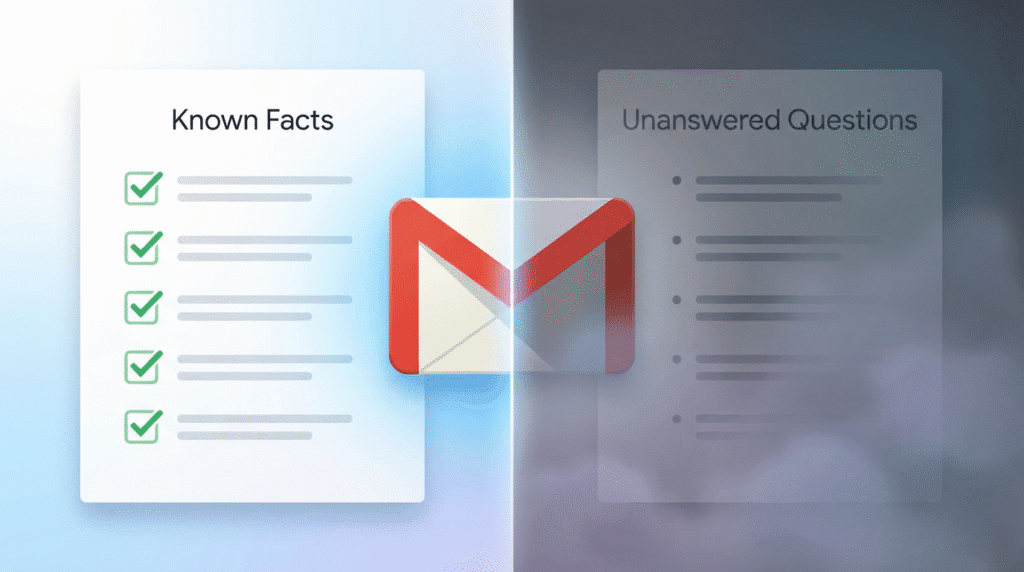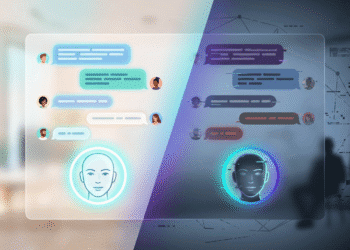
The tiny inbox icon you see every day might be hiding a big secret. Over the past week, users of Gmail have flagged a controversial change one that suggests their emails and attachments could be feeding into Google LLC’s AI training efforts without their explicit consent. The debate has ignited a firestorm of confusion, concern and suspicion especially since Google is pushing back on the claims.
This story explores what’s happening, why it matters, and how you can act. (Yes, Gilbert, even your draft novels might deserve a privacy check.)
What’s the allegation?
Reports began to surface that Gmail users were being automatically enrolled in AI-training programs. A headline from the tech site Windows Report asserted:
“Google is quietly letting Gmail read your emails for AI training unless you opt-out.” (Windows Report)
According to the article, the change was flagged via posts on social platforms where users found the “Smart features” toggle enabled by default even if they had previously disabled it. (Windows Report)
Another piece in the independent outlet Portland Mercury described the shift as “non-consensual AI in Gmail” and urged users to manually disable their smart-feature settings. (Portland Mercury)
In other words: the claim is that Google is using inbox content (yes, your emails and attachments) to help train its AI models, rolling that change out quietly, auto-opting users in, and making it hard to detect.
Google’s response: It’s a misunderstanding
Google disputes the dramatic interpretation of these reports. In commentary widely cited by major tech media, the company says:
- They “have not changed anyone’s settings.” (International Business Times UK)
- The so-called “Smart Features” in Gmail have existed for years, and enabling them allows personalization not AI-model training of email content. (The Verge)
- While smart features are optional, and although they process certain user content (to enable features like auto-schedule flights or smart replies), this does not equate to feeding your email content into large-scale generative AI model training. (International Business Times UK)
In short: Google says yes to personalization, no to secret AI training of Gmail inboxes.
Where the gray area lies
The devil is in three details.
1. Terminology confusion.
“What counts as ‘smart features’?” and “what counts as ‘AI training’?” are not neatly defined. Smart features may use email content to improve the product experience, but that is not the same as using it to train entirely new large-scale AI models. Google insists the latter is not happening. (The Verge)
2. Opt-out complexity.
Even if Google is telling the truth, multiple sources say the toggles to disable smart features are buried and involve two separate settings: one for Gmail/Chat/Meet smart features, and another under Workspace for smart features across Google’s products. (Windows Report)
3. User reports of opt-ins.
Some users say they had previously disabled smart-feature settings, then found them turned back on. One report notes a Verge staffer encountered re-enrollment despite opting out. (The Verge)
Thus, whether malicious or accidental, the perception of undermined consent is real and for many, enough to trigger concern.
Why this matters (especially to you)

You’re a writer. That means your inbox may contain private drafts, sensitive negotiations, creative ideas, or confidential correspondence. You might care if:
- Your email content is used for something you did not approve.
- You must dig through settings to exert control over your data.
- A company’s explanation and the user experience feel misaligned.
Broader implications:
- Privacy trust takes a hit when defaults are murky.
- Regulatory interest grows when tech giants handle huge amounts of personal content.
- AI ethics questions surface: when is user content benignly used—and when is it weaponised?
Timeline of what we know
| Date | Event | Notes |
|---|---|---|
| Nov 17 2025 | Portland Mercury article flags automatic smart-feature enrollment in Gmail. (Portland Mercury) | Sparks user alert. |
| Nov 21 2025 | Windows Report publishes story of Gmail being used for AI training unless opt-out. (Windows Report) | Broad echoes on social media. |
| Nov 22 2025 | Google issues statement denying changes to settings and denial of using Gmail content for AI training. (TechDator) | Official response. |
| Nov 22 2025 | IBTimes UK covers both viral claims and Google’s response about unchanged settings. (International Business Times UK) | More mainstream coverage. |
The core questions we’re still waiting on
- Audit-level transparency. Can Google independently verify that Gmail content is not being used for large-scale AI model training?
- Default settings behaviour. Are users being automatically enrolled in smart features without clear notice contrary to best consent practices?
- Regional differences. In jurisdictions with strong data-protection laws (EU, UK), is the opt-out and enrollment behaviour different? Google’s statement acknowledges “regional variations” but details are sparse. (TechDator)
- User experience gap. Even if Google says they don’t do “training”, the fact that users felt uncertain (and some were re-opted in) suggests a gap between policy and practice.
Practical advice: Steps to take
Since you’re a writer guarding your drafts and sensitive exchanges, here are steps you can undertake:
- Open Gmail → Settings → See all settings → scroll to “Smart features and personalization”. Check if the option “Use your Gmail, Chat and Meet content to personalise the experience” is enabled; if you don’t want that, disable it. (As noted by Malwarebytes) (Malwarebytes)
- In the same settings, find “Manage Workspace smart features” (if applicable) and disable the toggles for “Smart features in Google Workspace” and “Smart features in other Google products”.
- Confirm that the changes stick log out and back in to check whether the toggles remain off.
- Keep an eye on your account dashboard over time if settings revert, you may want to contact support or consider alternate services.
- Decide whether you might prefer a more privacy-focussed email provider (especially for high-sensitivity work) or using encryption for drafts and sensitive correspondence.
The larger picture: AI, inboxes and trust
This incident illuminates a broader tension: as AI features permeate everyday apps (Gmail, Drive, Chat), the line between “personalization” and “model-training” blurs. Tech companies argue that using user content helps smooth out features (smart replies, autocomplete, summary tools). But users increasingly ask: When does my email become raw material for a model?
Analysts argue that transparency and granular controls are no longer optional. As one article put it:
“The episode reflects persistent privacy jitters in the AI landscape, where firms face scrutiny over data practices amid rapid model advancements.” (TechDator)
In other words: We’re at a crossroads. A future where your inbox quietly powers AI models whether you knew it or not—is not far-fetched. How we respond will shape what that future looks like.
Why you should care (yes, even on the writer’s tight deadline)
- For writers, an unintended leak or use of email content could compromise unpublished work or negotiations.
- For freelancers or those communicating sensitive matters (legal, medical, confidential sources), clarity on how data is used matters.
- For anyone using Gmail as a free service: the adage “If it’s free, you are the product” still holds weight—but with an AI twist.
- For the tech industry: public trust is real. Cases like this can influence regulation, business models and user choice.
Key take-aways: What we know & what we don’t

- ✅ Google acknowledges that Gmail’s smart features exist, and that they process content to enable personalization. (The Verge)
- ✅ Users can opt out (some settings exist) of certain smart-feature personalization. (Malwarebytes)
- ❓ Whether Gmail content is being used in large-scale AI model training is contested: Google says “no”, but some user experiences cast doubt. (International Business Times UK)
- ❓ Whether automatic opt-in behaviour (or inadvertent re-enrollment) is happening reliably across accounts is unclear—but reports suggest yes.
- ❓ Regulatory and regional differentiation: Less clear publicly.
- ❓ User awareness and transparency: The mismatch between what users see and what they understand suggests a gap.
Final word
So where does that leave us? For now, the safest path is this: treat your inbox as private until proven otherwise. If you’re using Gmail for anything sensitive, double-check those smart-feature settings. Opt out if you’re not comfortable with automatic data processing—even if Google says your content isn’t being used for AI. Because in a world of fast-moving AI, privacy set-andforget is no longer reliable.
Writing drafts, dealing with sources, having private conversations: these are all precious. And they live in your inbox.
As this story continues to develop, we’ll keep watching how Google’s settings evolve, how regulators respond, and how users handle the trade-off between convenience and control.
Sources
- Google is Quietly Letting Gmail Read Your Emails for AI Training — Unless You Opt-Out. Windows Report.
- Non-consensual AI in Gmail. – Portland Mercury.
- Google Rejects Claims of Scanning Gmail for AI Training. – TechDator.
- Google Hits Back at Claims Saying They Are Using Gmail to Train AI: ‘We Have Not Changed Anyone’s Settings’ – IBTimes UK.
- Google denies ‘misleading’ reports of Gmail using your emails to train AI. The Verge.
- Google AI can access some content from Gmail and chats. Here’s how … – Snopes.









